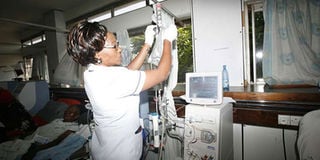NHIF records increased payouts for kidney illnesses

A nurse at Kenyatta National Hospital operates a dialysis machine. Dialysis purifies a patient’s blood. PHOTO | FILE | NATION MEDIA GROUP
What you need to know:
- In the last half of 2018, NHIF paid a further Sh64.7 million towards kidney transplants, up from Sh21.7 million in 2017.
- It is estimated that between 2,000 and 2,500 patients are on dialysis countrywide, against 10,000 who have been diagnosed with end stage kidney diseases.
National Hospital Insurance Fund payouts for treatment of kidney failure increased by 41 percent last year, with the agency releasing Sh1.8 billion for dialysis.
This was an increase of Sh1.24 billion in the 2016/17 financial year, highlighting the cost burden of the procedure to insurance companies.
In the last half of 2018, NHIF paid a further Sh64.7 million towards kidney transplants, up from Sh21.7 million in 2017.
This makes the procedure one of the top expenditure items in the healthcare benefit package.
Dialysis purifies a patient’s blood using a machine. It helps keep the body fluids and electrolytes balanced when kidneys no longer function properly.
DIALYSIS
The procedure balances the body fluids by removing wastes, extra water and salt and ensuring they do not build up to dangerous levels.
Dialysis also maintains a safe level of particular chemicals in the blood such as potassium, sodium and bicarbonate. It controls blood pressure in the process.
It is estimated that about four million — or 10 percent of Kenya’s population — are likely to develop kidney diseases in their lifetime.
Nairobi County was the biggest beneficiary of dialysis in the last half of 2018.
NHIF paid Sh922.8 million for 73,757 dialysis sessions countrywide.
Acting NHIF chief executive Nicodemus Odongo attributed the rise in spending to an increase in kidney failure cases.
“These previously were unmet needs. When the Fund started paying more, it appeared like there was an increase in patients,” Dr John Ngigi, the head of the renal unit at Kenyatta National Hospital, said.
LIFESTYLE
He however admitted that there is a slight increase in the number of people being diagnosed with end-stage kidney failure.
Dr Ngigi attributed the increase to diabetes, hypertension and other non-communicable ailments.
While the increase in payouts means more Kenyans are getting the much-needed service, Dr Ngigi says there are many who are not on treatment.
It is estimated that between 2,000 and 2,500 patients are on dialysis countrywide, against 10,000 who have been diagnosed with end stage kidney diseases.
“I am not surprised that NHIF payouts have gone up. There are more dialysis centres and equipment in Kenya and many people have access to treatment,” Dr Ngigi said.
He added that with NHIF, patients can go for dialysis or even kidney transplants.
POLICY
But the increase in payouts could also be a problem for NHIF if the payment model is not reworked.
“With the number of patients still untreated, the current model may not be sustainable. This information should inform policy on the need to encourage research and preventive medicine to contain chronic kidney diseases,” he said.
The benefit package utilisation report also shows that maternity payment for services decreased by six percent, from Sh1.6 billion to Sh1.5 billion.
Free maternity services paid under the Linda Mama programme however increased from Sh28 million to Sh1.5 billion.






